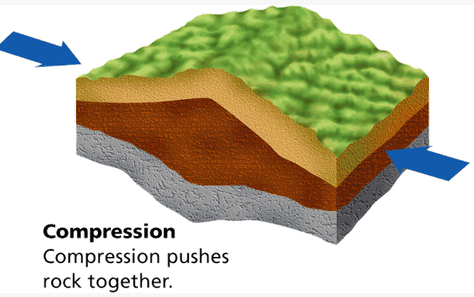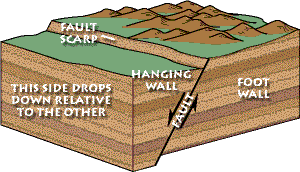At Which of the Following Faults Are Rocks Pulled Apart
When the hanging wall moves up it is called a reverse fault. The current transtensional state generates normal growth faults and some strike slip motion.

Different Types Of Faults Earthquakes And Faults Earthquakes Science Topics Learning Home Gns Science
Tension force pulls rock apart causing normal faults.

. TENSION stress of a fault occurs when slabs of rock are being pulled. What stress of a fault occurs when slabs of rock are being pulled apart from each other Weegy. The rocks slide on top of one another.
How do rock particles move during the passage of AP through the rock. Redrawn from University of Otago Richard Sibson 1. _______ stress of a fault occurs when slabs of rock are being pulled apart from each other.
Normal faults occur in places where there is tension or the rocks are being pulled apart. This stress on rocks result to slippage and translation of walls. Kaypeeoh72z and 59 more users found this answer helpful.
Which of the following occurs when rocks are pulled apart. Rocks slides horizontally against each other. Identify what changes happen to the following objects with the application of force.
It occurs on convergent plate boundaries. Patrick transfers the table from the sala to his bedroom. A reverse fault a fault in which the faults push together.
Fractures that are simple cracks where the rock has pulled apart. Based on the description the fault shown in the picture is a reverse fault. Triangulation is the process used to locate the epicenter of an earthquake.
Tensional stress of a fault occurs when slabs of rock are being pulled apart from each other. The Salton Trough is an active pull-apart located in a step-over between the dextral San Andreas Fault and the Imperial Fault. The Himalayas Type of weathering that.
_____ stress of a fault occurs when slabs of rock are being pulled apart from each other. The common type of stress found on divergent plate boundaries. Displacement on the fault is approximately 6 cmyr.
It causes rocks to be pulled apart. A fault is best described as fractured rock that has been displaced. Where the crust is being compressed reverse faulting occurs in which the.
Kate applies force on the brake to stop the car. Reverse faults are caused by compressional forces. The growth faults in the region strike N15E have steep dips 70 deg and vertical displacements of 14.
Rocks above the fault move up. They are located on the edge of tectonic plates and cut the ridges perpendicularly. Rocks being pulled apart are under tension.
Two normal faults cut through a block of rock the hanging wall between each slips downward the rock between moves upward forming a fault-block mountain. Transforming faults are lithospheric plate limits where there is neither subduction nor creation of lithosphere. It causes rocks to lengthen and break apart.
Which of the following faults could result from both strike-slip and dip-slip stresses. This is found at divergent plate boundaries. A fault displaces the rocks on one side relative to another.
Which of the following is a common metamorphic process. This type of stress squeezes rocks. The correct answer is E.
A low angle reverse fault is called a thrust fault because one side is being thrust onto the other. It is a tension fault. Leo smashes tin cans before bringing it to the junkshop.
They move through the rock via compression very much like sound waves move through the air. Which of the following occurs when rocks bend break or flow during mountain building. It causes rocks to fold or fracture.
Particles of rock move forward and back during the passage of the P waves. Where the crust is being pulled apart normal faulting occurs in which the overlying hanging-wall block moves down with respect to the lower foot wall block. Question and answer.
Tension stress of a fault occurs when slabs of rock are being pulled apart from each other. Types of movement of crustal blocks that can occur along faults during an earthquake. Which process is used to locate the epicenter of an earthquake Weegy.
A fault displaces the rocks on one side relative to another. 1 tension This force pulls rocks apart and creates a normal fault. There are three types of faults.
Rocks are pulled apart and creates a space between them. Change in sizeshape Alex tore the colored papers int. Fault Block Mountains.
Fault The Shape Of The Land Forces And Changes Spotlight On Famous Forms For More Information

No comments for "At Which of the Following Faults Are Rocks Pulled Apart"
Post a Comment